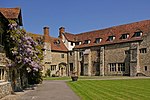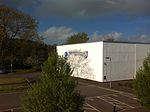Aylesford

Aylesford is a village and civil parish on the River Medway in Kent, England, 4 miles (6 km) northwest of Maidstone. Originally a small riverside settlement, the old village comprises around 60 houses, many of which were formerly shops. Two pubs, a village shop and other amenities are located on the high street. Aylesford's current population is around 5,000.The Parish of Aylesford covers more than seven square miles (18 km2), stretching north to Rochester Airport estate and south to Barming, and has a total population of over 10,000 (as of 2011), with the main settlements at Aylesford, Eccles, Blue Bell Hill and (part of) Walderslade.Aylesford Newsprint was a long-established major employer in the area and was the largest paper recycling factory in Europe, manufacturing newsprint for the newspaper industry. In 2015, Aylesford Paper Mill, as it was known by local residents, was closed down and stripped of all its assets.
Excerpt from the Wikipedia article Aylesford (License: CC BY-SA 3.0, Authors, Images).Aylesford
High Street, Tonbridge and Malling Aylesford
Geographical coordinates (GPS) Address Nearby Places Show on map
Geographical coordinates (GPS)
| Latitude | Longitude |
|---|---|
| N 51.3033 ° | E 0.4796 ° |
Address
High Street
ME20 7BA Tonbridge and Malling, Aylesford
England, United Kingdom
Open on Google Maps









